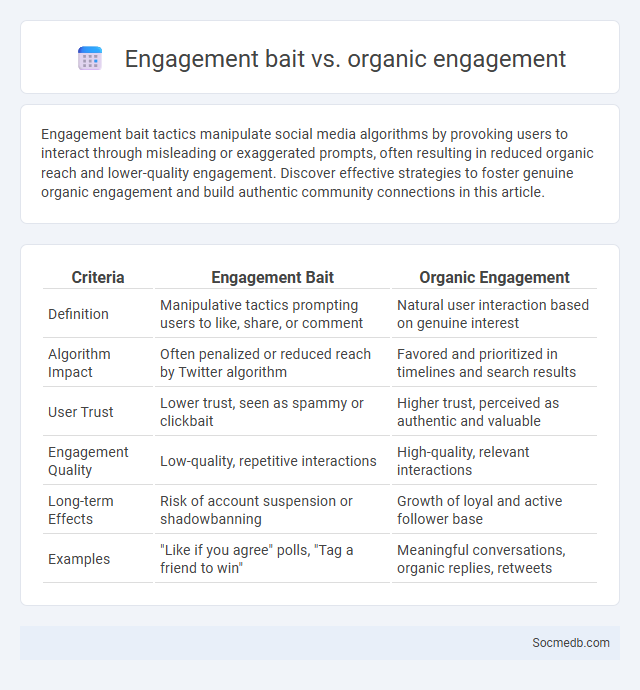
Photo illustration: Engagement bait vs Organic engagement
Engagement bait tactics manipulate social media algorithms by provoking users to interact through misleading or exaggerated prompts, often resulting in reduced organic reach and lower-quality engagement. Discover effective strategies to foster genuine organic engagement and build authentic community connections in this article.
Table of Comparison
| Criteria | Engagement Bait | Organic Engagement |
|---|---|---|
| Definition | Manipulative tactics prompting users to like, share, or comment | Natural user interaction based on genuine interest |
| Algorithm Impact | Often penalized or reduced reach by Twitter algorithm | Favored and prioritized in timelines and search results |
| User Trust | Lower trust, seen as spammy or clickbait | Higher trust, perceived as authentic and valuable |
| Engagement Quality | Low-quality, repetitive interactions | High-quality, relevant interactions |
| Long-term Effects | Risk of account suspension or shadowbanning | Growth of loyal and active follower base |
| Examples | "Like if you agree" polls, "Tag a friend to win" | Meaningful conversations, organic replies, retweets |
Understanding Engagement Bait: Definition and Examples
Engagement bait refers to social media posts deliberately crafted to provoke interactions such as likes, shares, comments, or reactions by using tactics like asking users to tag friends, vote, or share opinions. Platforms like Facebook and Instagram actively demote these posts in their algorithms to reduce spammy content and maintain authentic user experiences. Recognizing common examples such as "Tag a friend who needs to see this!" or "Like if you agree!" helps users and marketers create genuine, meaningful engagement instead of manipulative interactions.
What is Organic Engagement? Key Characteristics
Organic engagement on social media refers to the interactions users have with content without paid promotion, including likes, comments, shares, and saves. Key characteristics include authenticity, driven by genuine interest and trust in the content, and long-term audience building through consistent, relevant posts. It highlights the importance of community interaction and meaningful conversations rather than quick, transactional metrics.
Engagement Bait vs Organic Engagement: Core Differences
Engagement bait exploits users by prompting actions like likes, shares, or comments through manipulative phrases, often resulting in reduced reach due to platform penalties. Organic engagement arises naturally from authentic, valuable content that encourages genuine interactions without explicit calls to action. Social media algorithms prioritize organic engagement because it signals meaningful user interest, fostering long-term community growth over superficial metrics.
The Psychological Impact of Engagement Bait
Engagement bait on social media platforms manipulates users by encouraging excessive interactions like likes, shares, and comments, which can amplify feelings of anxiety and low self-esteem. Your constant exposure to such content distorts genuine social validation, often leading to addictive behavior and reduced mental well-being. Understanding this psychological impact is crucial for fostering healthier online experiences and protecting your emotional health.
Algorithm Responses: How Platforms Treat Each Approach
Social media platforms employ distinct algorithmic responses to organic, paid, and influencer content, prioritizing user engagement signals such as clicks, shares, and comments. Algorithms on platforms like Facebook and Instagram favor personalized feeds, boosting posts that generate higher interaction rates and retention time, while Twitter's real-time feed emphasizes trending topics and recency. TikTok's recommendation system utilizes machine learning to analyze user behavior, selectively promoting content based on watch time and feedback, resulting in highly tailored algorithmic curation across different approaches.
Pros and Cons of Engagement Bait Strategies
Engagement bait strategies on social media, such as asking users to like, share, or comment, can rapidly increase interaction rates and enhance algorithmic visibility, boosting brand awareness and reach. However, these tactics often lead to superficial engagement without genuine interest, reducing long-term follower loyalty and negatively impacting the credibility of the account. Platforms like Facebook and Instagram actively demote engagement bait content, which can limit organic reach and harm overall social media performance.
The Value and Longevity of Organic Engagement
Organic engagement on social media generates authentic interactions that build trust and foster long-term community loyalty. Brands leveraging organic reach benefit from sustained visibility without the high costs associated with paid advertising, enhancing return on investment. Consistent, quality content encourages meaningful conversations, driving lasting brand affinity and improved algorithmic favorability.
Detecting and Avoiding Engagement Bait Tactics
Detecting and avoiding engagement bait tactics on social media helps maintain genuine interactions and protects your account from algorithm penalties. These tactics often include prompts like "Tag a friend," "Share if you agree," or exaggerated claims aiming to artificially increase likes, comments, or shares. Recognizing such patterns ensures your engagement remains authentic, improving your content's visibility and credibility.
Best Practices for Building Genuine Engagement
Effective social media engagement requires authentic interactions that prioritize quality over quantity, fostering meaningful connections through personalized responses and active listening. Utilizing data-driven insights to tailor content to your audience's interests enhances receptivity and encourages organic sharing. Your consistent presence and transparent communication build trust, transforming followers into loyal community members.
Choosing the Right Approach: Maximizing Social Media Success
Selecting the right social media strategy involves analyzing target audience behavior, platform-specific features, and content types that generate the highest engagement. Utilizing data-driven insights and A/B testing helps optimize posting schedules and messaging for platforms like Instagram, Facebook, Twitter, and LinkedIn. Tailoring content to each channel's unique algorithms and user preferences significantly boosts reach, interaction, and overall campaign effectiveness.
 socmedb.com
socmedb.com